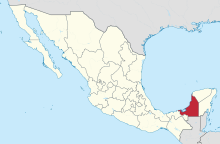Campeche | |
|---|---|
| Free and Sovereign State of Campeche Estado Libre y Soberano de Campeche (Spanish) Xóot' Noj Lu'umil Kaampech (Yucatec Maya) | |
| Anthem: Himno Campechano | |
| Coordinates: 19°0′N 90°24′W / 19.000°N 90.400°W | |
| Country | Mexico |
| Capital and largest city | San Francisco de Campeche |
| Municipalities | 13 |
| Admission | April 29, 1863[1] |
| Order | 25th[a] |
| Government | |
| • Governor | |
| • Senators[2] | |
| • Deputies[3] | |
| Area | |
• Total | 57,507 km2 (22,204 sq mi) |
| Ranked 17th | |
| Highest elevation | 390 m (1,280 ft) |
| Population (2020)[6] | |
• Total | 928,363 |
| • Rank | 30th |
| • Density | 16/km2 (42/sq mi) |
| • Rank | 29th |
| Demonym | Campechano (a) |
| GDP | |
| • Total | MXN 521 billion (US$25.9 billion) (2022) |
| • Per capita | (US$27,562) (2022) |
| Time zone | UTC−6 (Central) |
| Postal code | 24 |
| Area code | |
| ISO 3166 code | MX-CAM |
| HDI | |
| Website | Official website |
| ^ a. Separated from Yucatán on May 3, 1858, was federal territory from 1858 to 1863. | |
Campeche (Spanish pronunciation: [kamˈpetʃe] ; Yucatec Maya: Kaampech [ˈkàːmpetʃ]), officially the Free and Sovereign State of Campeche (Spanish: Estado Libre y Soberano de Campeche), is one of the 31 states which, with Mexico City, make up the 32 federal entities of Mexico. Located in southeast Mexico, it is bordered by the states of Tabasco to the southwest, Yucatán to the northeast, Quintana Roo to the east, by the Petén department of Guatemala to the south, and by the Orange Walk District of Belize to the southeast. It has a coastline to the west with the Gulf of Mexico. The state capital, also called Campeche, was declared a World Heritage Site in 1997. The formation of the state began with the city, which was founded in 1540 as the Spanish began the conquest of the Yucatán Peninsula. The city was a rich and important port during the colonial period, but declined after Mexico's independence. Campeche was part of the province of Yucatán, but split off in the mid-19th century, mostly due to political friction with the city of Mérida. Much of the state's recent economic revival is due to the discovery of petroleum offshore in the 1970s, which has made the coastal cities of Campeche and Ciudad del Carmen important economic centers. The state has important Mayan and colonial sites; however, these are not as well-known or visited as much as others in the Yucatán.
The state's executive power rests in the governor of Campeche and the legislative power rests in the Congress of Campeche, which is a unicameral legislature composed of 35 deputies.
Cite error: There are <ref group=lower-alpha> tags or {{efn}} templates on this page, but the references will not show without a {{reflist|group=lower-alpha}} template or {{notelist}} template (see the help page).
- ^ "SEP". sepdf.gob.mx (in Spanish). Archived from the original on October 26, 2011.
- ^ "Senadores por Campeche LXI Legislatura". Senado de la Republica. Archived from the original on January 7, 2019. Retrieved October 20, 2010.
- ^ "Grupos Prlamentarios". diputados.gob.mx. Camara de Diputados LXIII Legislatura. Archived from the original on October 20, 2018. Retrieved September 16, 2015.
- ^ "Resumen". cuentame.inegi.gob.mx. Cuentame INEGI. Archived from the original on May 13, 2013. Retrieved February 12, 2013.
- ^ "Relieve". cuentame.inegi.gob.mx. Cuentame INEGI. Archived from the original on September 30, 2011. Retrieved October 20, 2010.
- ^ "México en cifras". cuentame.inegi.gob.mx. January 2016. Archived from the original on July 18, 2021. Retrieved January 26, 2021.
- ^ "Indicadores Regionales de Actividad Económica 2023" (PDF). banamex.com (in Spanish). June 13, 2023. Archived (PDF) from the original on June 17, 2023. Retrieved August 13, 2023.


